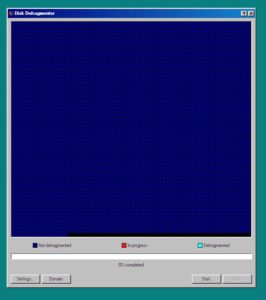Back in the 1990s, hard drive defragmentation was an essential part of weekly computer maintenance — and for some people, it was the best part. 
Windows 95 and 98 provides a graphical disk defragmenter with a grid that gradually changed color as sectors were treated. You couldn’t do too much while the defragmenter was running; you’d simply sit back with your Surge (or Orbitz, or Zima) and wait for the process to finish.
If you’re feeling nostalgic, you can enjoy that experience again on defrag98.com, a defragmentation simulator built by Dennis Morello.
“One of the biggest challenges was implementing a defragmentation algorithm that felt authentic,” Morello wrote in a blog post announcing the project. “I created a custom algorithm that: randomly selects clusters to process, simulates file movements across the disk, [and] adjusts processing speed based on the selected virtual drive.”
“This project was a fantastic opportunity to deep dive into the intricacies of writing a custom defrag algorithm, and find a balance between performance and simulation accuracy.”
Of course, Defrag98 won’t actually defragment your hard drive.
As we’ve discussed in other articles, manual defragmentation is no longer necessary; modern operating systems use more efficient filesystems and have built-in features to manage defragmentation without user input.
Besides, there’s a good chance that your computer has a solid-state drive (SSD), not a hard drive — and traditional defragmentation is actually bad for SSDs.
Defrag98 is an incredible achievement, but it won’t actually change the way your computer operates (for better or worse). However, it’s great for nostalgia — it even simulates the sounds of an older hard drive, which can be changed by selecting another “drive” from the web app’s menu.
What was Windows 98’s Disk Defragmenter doing, anyway?
Defragmentation is a process that reorganizes data on a hard drive.
A hard drive stores data in sectors, which are like small containers. When you save a file, it’s broken down into pieces and stored in available sectors. Over time, these pieces can become scattered across the drive.
Defragmentation gathers these scattered pieces and moves them to contiguous sectors. This means the file’s data is stored closer together. By doing this, the hard drive can access the file’s data more quickly, improving overall system performance.
Windows 98’s Disk Defragmenter showed this reorganization graphically via its grid. It would also indicate bad sectors, which could be useful in data recovery diagnoses in the late 1990s — but fortunately, it’s been a long time since we’ve analyzed Disk Defragmenter readouts.
Data Recovery Resources for Hard Drives, SSDs, and Other Storage Devices
If you’ve noticed excessive fragmentation on a hard drive — or other symptoms such as slow operation, clicking sounds, or file corruption — Datarecovery.com is here to help.
With full-service laboratories at each location, risk-free evaluations, and our no data, no charge guarantee, we provide expert resources for data recovery, file repair, ransomware recovery, and more. Call 1-800-237-4200 to speak with an expert or submit a case online for a free media evaluation.




